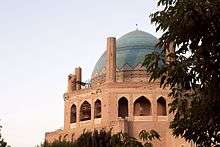Dome of Soltaniyeh
| Soltaniyeh | |
|---|---|
| Name as inscribed on the World Heritage List | |
 | |
| Type | Cultural by Azeri style |
| Criteria | ii, iii, iv |
| Reference | 1188 |
| UNESCO region | Asia-Pacific |
| Inscription history | |
| Inscription | 2005 (29th Session) |
The central magnet of Soltaniyeh's several ruins is the Mausoleum of Il-khan Öljeitü also known as Muhammad Khodabandeh, traditionally known as the Dome of Soltaniyeh in Soltaniyeh city, Zanjan Province.

The structure, erected from 1302 to 1312 AD, has the oldest double-shell dome in Iran.[1] This erroneous view of the construction was made by Dieulafoy but is totally disputed by Andre Godard.[2] In Godard's view it is a normal, if spectacularly large dome, with a thin skin on top for the faience and is in no way a double dome. Its importance in the Muslim world may be compared to that of Brunelleschi's cupola for Christian architecture. It is one of the largest brick domes in the world, just at the theoretical engineering limit for a brick dome and the third largest dome in the world after the domes of Florence Cathedral and Hagia Sophia.[1] The Dome of Soltaniyeh paved the way for more daring Iranian-style cupola constructions in the Muslim world, such as the Mausoleum of Khoja Ahmed Yasavi and the Taj Mahal. Much of its exterior decoration has been lost, but the interior retains superb mosaics, faience, and murals. People have described the architecture of the building as “anticipating the Taj Mahal.”
The estimated 200 ton dome stands 49 meters (161 ft) tall from its base, and is currently undergoing extensive renovation.
Photo gallery
 Village of Soltaniyeh and dome in 1969
Village of Soltaniyeh and dome in 1969
- Major reconstruction inside
- 16th century map of Soltaniyeh city
- 16th century map of Soltaniyeh city
 interior view
interior view

See also
References
| Wikimedia Commons has media related to Soltaniyeh. |
Coordinates: 36°26′07″N 48°47′48″E / 36.4353°N 48.7967°E